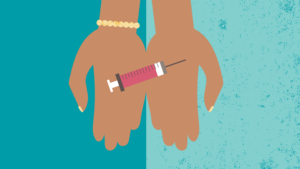Archive: Injectables Toolkit
Archive:
Injectables Toolkit
You have reached this page either from the main Toolkits Archive page or because you followed a link to a page or resource that used to be in a K4Health Toolkit. The Toolkits platform has been retired.
 This Toolkit included information for health policy makers, program managers, and service providers about progestin-only injectables; combined (monthly) injectables; community-based access to injectables, an effective strategy for increasing access to injectable contraceptives; and subcutaneous DMPA (depo-subQ), a lower-dose formulation of DMPA that is injected under the skin rather than in the muscle. This Toolkit was originally created by the Knowledge for Health (K4Health) Project.
This Toolkit included information for health policy makers, program managers, and service providers about progestin-only injectables; combined (monthly) injectables; community-based access to injectables, an effective strategy for increasing access to injectable contraceptives; and subcutaneous DMPA (depo-subQ), a lower-dose formulation of DMPA that is injected under the skin rather than in the muscle. This Toolkit was originally created by the Knowledge for Health (K4Health) Project.
Toolkit Alternatives
- Explore 20 Essential Resources: Self-Care for Family Planning
- Peruse other Knowledge SUCCESS content about injectable contraception
- View/download Chapter 4, Progestin-Only Injectables, and Chapter 5, Monthly Injectables, from Family Planning: A Global Handbook for Providers
- Search FP insight for injectables resources, including this collection on family planning self-care in Asia
- View/download the Family Planning Training Resource Package module on progestin-only injectable contraception
- Visit past captures of the Injectables Toolkit on the Internet Archive’s Wayback Machine
If you urgently require a specific resource from a retired Toolkit, contact toolkits-archive@knowledgesuccess.org.





